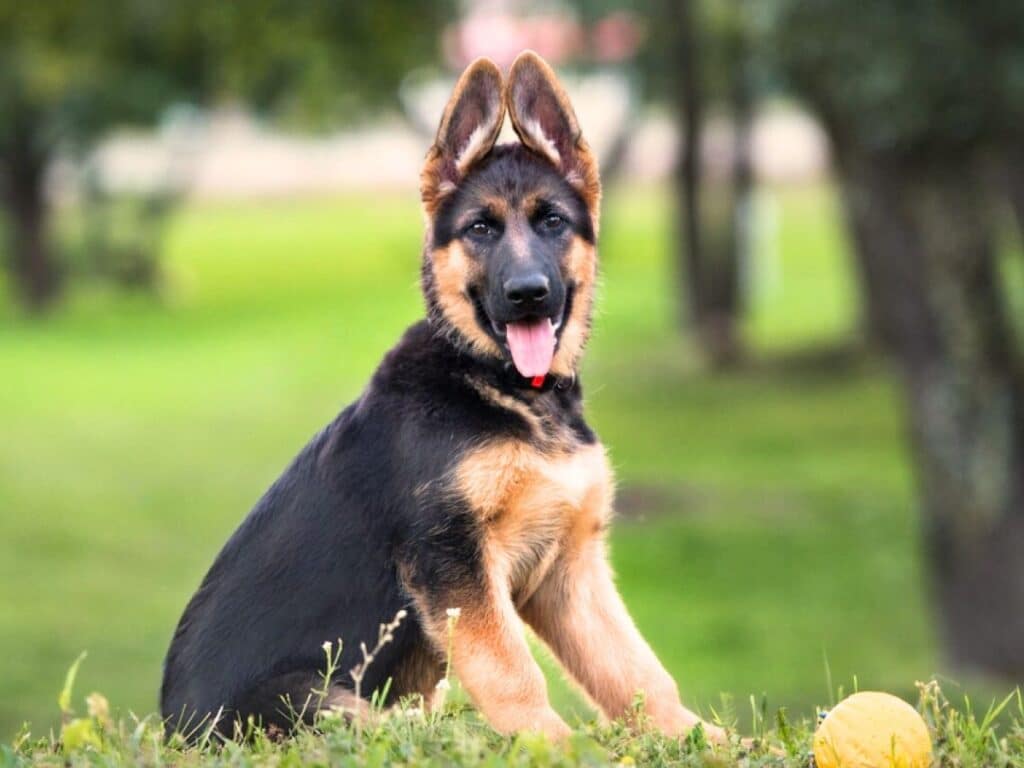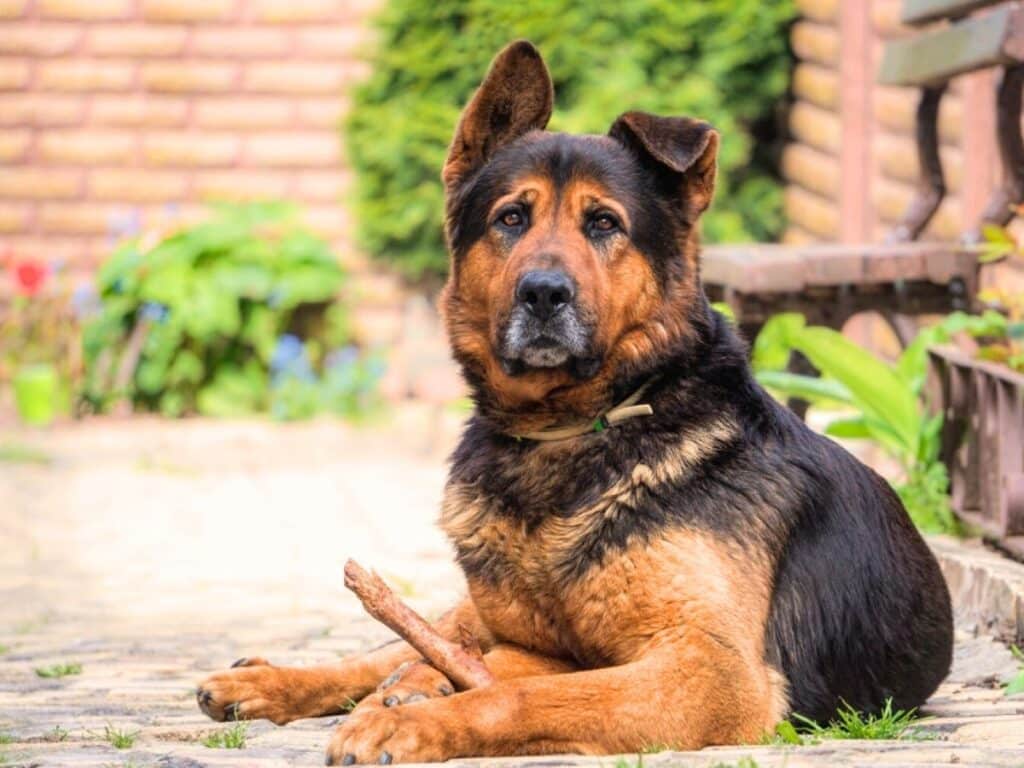If you know anything about GSDs then you may already know that a German Shepherd puppy’s ears go through several stages of development throughout its adolescent life.
They start with having floppy ears at a young age that eventually develop into their signature pointy ears.
In this post, we’ll explore the various German Shepherd puppy ear stages and discuss why it’s important for new GSD owners to understand this process.
German Shepherd Puppy Ear Stages from newborn to 18 months
The ear development of a German Shepherd puppy from birth to 18 months old goes through several stages. During this time, the ears transition from being floppy to erect, a defining characteristic of the breed.
Birth to 2 weeks
When a German Shepherd puppy is born, its ears are folded and flat against its head.

The cartilage is soft and pliable, and the puppies are completely reliant on their mother for care and nourishment.
2 to 3 weeks
Around the second or third week, the puppy’s ears might start to show some signs of unfolding.
They might become slightly raised or begin to show a hint of their adult shape.
However, during this stage, the ears are still quite floppy and not fully erect.
3 to 4 weeks
As the German Shepherd puppy reaches the three to four-week mark, you might notice a more noticeable change in their ears.

They begin to stand up intermittently but still tend to flop down at times. The cartilage continues to harden and develop, providing support for the ears.
5 to 7 weeks
By the fifth week, the German Shepherd puppy’s ears should become more consistently erect.

They might still occasionally flop down or tilt sideways, but overall, they maintain a more upright position.
The cartilage continues to strengthen, helping the ears stay erect for longer periods.
If a puppy’s ears start to droop again at this stage, it could be due to teething or growth spurts. This is usually temporary and should not last long.
8 to 12 weeks
During this stage, the ears of a German Shepherd puppy should become increasingly erect and firm.
By the eighth week, they should stand tall most of the time, although they might still show some occasional floppiness.

The ears are nearing their final shape and will continue to become more rigid and upright.
12 weeks to 5 months
As the German Shepherd puppy approaches five months old, the ears should be almost fully erect.

By this stage, they should stand proudly and consistently.
The cartilage has hardened considerably, and the puppy’s ears have likely attained their adult shape and position.
It’s important to note that each German Shepherd puppy develops at its own pace, and there can be variations in the rate of ear development.
Some puppies may have fully erect ears by four months, while others may take a bit longer.
If a puppy’s ears do not stand up by five to six months, it is recommended to consult a veterinarian to rule out any underlying issues.
5 to 6 months
At five months old, the German Shepherd puppy’s ears should be fully erect and relatively stable.
However, during this stage, it is common for the ears to appear oversized in proportion to the puppy’s head.

As the puppy grows and their head fills out, the ears will gradually become more proportionate to their size.
6 to 8 months
During this period, the German Shepherd’s head continues to develop, and the ears may appear a bit large or out of proportion.
The ears will likely have a more mature look, with well-defined edges and a firm, upright position.

It’s important to note that individual variations can occur, and some puppies may experience slight fluctuations in ear position or posture during this time.
8 to 12 months
As the German Shepherd puppy approaches one year of age, the ears should continue to develop in harmony with the head and body.
The proportions of the ears become more balanced, and any excess size should gradually diminish.
At this stage, the ears should maintain their erect position and demonstrate stability.
12 to 18 months
Between one year and 18 months old, the German Shepherd puppy’s ear development enters the final stages.
The ears should be well-proportioned to the head, giving the dog a balanced and alert appearance.

Although there may be subtle changes in the dog’s expression and ear positioning based on mood or environment, the ears should remain upright and maintain their characteristic shape.
It’s important to note that while most German Shepherds have fully erect ears by the time they reach one year of age, some puppies may experience a longer period of maturation.
Occasionally, a puppy’s ears may go through temporary phases of drooping or leaning to the side due to teething, growth spurts, or changes in muscle tone.
However, this is usually a temporary phase, and the ears will typically regain their erect position as the puppy continues to mature.
It’s essential to note that some German Shepherd puppies may never have fully erect ears. In some cases, one ear may stand up while the other remains floppy.
This condition is known as a “broken ear” and is not uncommon in German Shepherds. As long as your pup’s ears are healthy and not causing them any pain, there is no need for concern.
RELATED: Floppy Eared German Shepherd: Why & How To Fix It
Factors That Influence How Long It Takes for German Shepherd Puppy Ears to Stand Up
While most German Shepherd puppies’ ears typically become erect by around five to six months of age, individual variations can occur.
Here are some factors that can affect the timeframe for ear development:
1. Genetics
Genetics plays a significant role in ear development. The inheritance of genes from the parents determines the strength and structure of the cartilage in the ears.
If a puppy’s parents have strong, well-upright ears, it is more likely that the puppy’s ears will develop and stand up at an earlier age.
Conversely, if the parents have floppy or weak ears, it may take longer for the puppy’s ears to become erect.
2. Teething and growth spurts
The teething process and growth spurts can temporarily impact ear development.
During these periods, the puppy’s body is undergoing rapid changes, which can affect the positioning and stability of the ears.
It is not uncommon for a puppy’s ears to temporarily droop or lean to the side during these stages.
Once teething and growth spurts subside, the ears usually regain their erect position.
3. Nutrition
Proper nutrition is crucial for healthy ear development. Providing a well-balanced diet that meets the nutritional needs of a growing German Shepherd puppy is important.
Essential nutrients like protein, vitamins, and minerals contribute to the overall development of strong cartilage and supportive tissues, including those in the ears.
Consult with a veterinarian to ensure the puppy’s diet is appropriate for optimal growth.
Make sure that you check out this article to learn more about feeding your GSD puppy.
4. Exercise and muscle development
Regular exercise and physical activity can help promote strong muscle development, including the muscles that support the ears.
Adequate exercise and playtime can contribute to overall muscle tone, which can have a positive impact on ear development.
However, excessive or strenuous exercise during the early months may strain the puppy’s ears and potentially delay their ability to stand up.
5. Ear care and cleanliness
Maintaining good ear hygiene is essential for preventing infections or other issues that can affect ear development.
Regular cleaning, ensuring the ears are dry after bathing or swimming, and keeping them free from debris and irritants can help promote healthy ear development.
When to Be Concerned About Your German Shepherd Puppy’s Ear Development

Abnormal ear development in German Shepherd puppies can sometimes occur, and it’s important to be aware of the signs so that appropriate measures can be taken.
Here are some signs that may indicate abnormal ear development:
1. Persistent floppiness
While German Shepherd puppies typically have floppy ears at birth, by around five to six months of age, their ears should start to stand up.
If a puppy’s ears remain consistently floppy beyond this timeframe without showing any signs of firming up, it could be a sign of abnormal ear development.
2. Asymmetry
If one ear stands up while the other remains floppy or if there is a noticeable difference in the position or shape of the ears, it could indicate an abnormality.
Both ears should develop and stand up in a relatively symmetrical manner.
3. Weak cartilage
If the cartilage in a puppy’s ears feels noticeably weak, soft, or pliable even after the expected age of full ear development, it could suggest an issue.
Healthy ear cartilage should feel firm and provide support for the ears.
4. Pain or discomfort
If a puppy shows signs of pain or discomfort when their ears are touched, such as whining, pulling away, or showing signs of sensitivity, it could indicate an underlying problem.
It’s important to observe the puppy’s behavior and consult with a veterinarian if there are any concerns.
5. Inflammation or discharge
Redness, swelling, or discharge from the ears may indicate an infection or other underlying issue affecting the ear development. Such symptoms should be evaluated by a veterinarian.
6. Unresponsiveness to sounds
While it is normal for puppies to be less responsive to sounds during their early weeks, by around five to six weeks of age, they should start demonstrating heightened awareness of their surroundings.
If a puppy consistently fails to respond to sound stimuli or shows signs of hearing impairment, it could be related to abnormal ear development.
If you observe any of these signs in a German Shepherd puppy, it is recommended to consult with a veterinarian or seek the advice of an experienced breeder.
How to Help Your German Shepherd Puppy’s Ears Stand Up Naturally

If you have a German Shepherd puppy whose ears are not standing up as expected, there are a few measures you can take to help promote natural ear development.
While these methods do not guarantee results, they may provide some assistance. Here are some tips to consider:
1. Massage the ears
Gently massage your puppy’s ears to promote blood circulation and strengthen the muscles and cartilage.
Use your fingertips to massage the base of the ears in circular motions. This can help stimulate the cartilage and encourage the ears to stand up.
2. Use ear supports
There are various types of ear supports available in the market, such as breathable foam supports or specialized ear tape.
These supports can be used to provide additional support to the ears, helping them to stand up.
However, it’s important to follow the manufacturer’s instructions and consult with a veterinarian or experienced breeder before using any products.
We will discuss more on this later in the article.
3. Proper nutrition
Ensure your puppy receives a balanced and nutritious diet appropriate for their age and breed.
Adequate nutrition plays a vital role in overall growth and development, including the strength of cartilage and supportive tissues.
Consult with a veterinarian to ensure your puppy’s diet meets its specific nutritional needs.
4. Regular exercise
Regular physical exercise and playtime can help develop strong muscles, including those that support the ears.
Engage your puppy in age-appropriate activities and exercises that encourage overall muscle development.
However, avoid excessive or strenuous exercise that may strain the ears or impact their development.
4. Environmental stimulation
Providing a stimulating environment can encourage alertness and natural ear positioning. Introduce your puppy to different sounds, objects, and environments to promote their awareness and natural response.
This can help strengthen the muscles responsible for ear movement and contribute to their natural development.
5. Patience and time
Remember that every puppy develops at their own pace. It may take time for the ears to naturally stand up, even with the application of various techniques.
Be patient and allow your puppy’s ears to develop at their own rate. In many cases, the ears will naturally become erect as the puppy grows older.
It’s essential to note that while these measures may assist in promoting natural ear development, they do not guarantee results for every puppy.
The Importance of Proper Nutrition for German Shepherd Puppy Ear Development

A balanced and nutritionally complete diet, whether raw or commercial, is crucial for the overall health of a puppy, and it also plays a vital role in their ear development.
Nutrients such as protein, calcium, phosphorus, and vitamins are essential in promoting healthy ear growth.
A deficiency in these nutrients can lead to stunted or delayed ear development.
Recommended Diet Guidelines for Promoting Healthy Ear Growth
To ensure proper nutrition for your German Shepherd puppy’s ear development, you need to provide them with high-quality food that contains all the necessary nutrients. Here are some recommended diet guidelines:
1. Choose Quality Food
Quality matters more than quantity. Choose food that is specifically formulated for puppies and meets their nutritional needs.
Look for brands that use high-quality ingredients such as real meat or fish as the primary source of protein.
Avoid cheap dog food brands that contain fillers like corn or soybean meal because they lack adequate amounts of essential nutrients required by your pup during this critical stage.
2. Provide Sufficient Protein
Protein is an essential nutrient required by puppies for healthy growth and development. It helps build strong muscles and tissues needed for proper ear formation.
Ensure that your pup’s diet contains at least 22% protein content to promote healthy ear growth.
3. Incorporate Calcium & Phosphorus
Calcium and phosphorus are essential minerals required for bone formation. They help strengthen the cartilage in your puppy’s ears, which is crucial for proper ear development.
Ensure that your pup’s diet contains at least 1% calcium and 0.8% phosphorus content to promote healthy ear growth.
4. Add Vitamins
Vitamins such as A, C, D, E, and K play a vital role in promoting healthy ear growth in puppies.
Vitamin A helps maintain healthy skin and tissues while Vitamin C aids collagen production needed for cartilage formation.
Ensure that your pup’s diet contains adequate amounts of these vitamins to promote healthy ear growth.
Taping German Shepherd Puppy Ears: A Step-by-Step Guide
Materials Needed for Posting Ears
Before starting the taping or ear-posting process, it is important to gather all the necessary materials. The following items are essential for successful ear taping:
- Bunny ears or foam inserts
- Medical adhesive tape
- Fabric glue or Tear Mender
- Scissors
Best Practices for Taping German Shepherd Puppy Ears
It is crucial to follow best practices when posting ears. Here are some tips to keep in mind:
- Start early – ideally, the ear-taping process should begin when the puppy is between 6 and 12 weeks old.
- Keep the ears clean and dry before beginning the process.
- Use medical adhesive tape that is breathable and gentle on the skin.
- Do not pull too tightly on the tape, as this can cause discomfort and irritation for the puppy.
- Check on the puppy’s ears regularly to ensure they are healing properly.
Step-by-Step Guide for Taping German Shepherd Puppy Ears
- Begin by cleaning your puppy’s ears with a mild cleanser and drying them thoroughly.
- Cut a piece of medical adhesive tape that is approximately 4 inches long.
- Fold one end of the tape over onto itself to create a small tab.
- Place one bunny ear or foam insert into your puppy’s ear flap.
- Gently pull up on your puppy’s ear until it stands upright.
- Hold the bunny ear in place against your puppy’s head with one hand while using your other hand to wrap the taped end of the medical adhesive tape around both sides of your puppy’s head, just above its eyes.
- Wrap another piece of medical adhesive tape around both sides of your puppy’s head, just behind their ears, securing both bunny ears in place.
- Use fabric glue or Tear Mender to secure the edges of the tape to your puppy’s fur, ensuring that it is not too tight and does not cause discomfort.
- Repeat the process on the other ear.
- Check on your puppy’s ears regularly to ensure they are healing properly and adjust the tape as needed.
Taping a German Shepherd puppy’s ears can be a time-consuming process, but it is essential for their health and well-being. By following these step-by-step instructions and best practices, you can help ensure that your puppy’s ears stand up straight and strong.
Tips for Successfully Taping German Shepherd Puppy Ears

Avoiding Common Mistakes
Posting a German Shepherd puppy’s ears is an important part of the breed standard. However, it can be a challenging process, and many owners make mistakes that can lead to unsuccessful results.
Here are some common mistakes to avoid when posting ears:
- Using the wrong tape: One of the most common mistakes is using tape that is too weak or too strong. If the tape is too weak, it won’t hold the ear in place, and if it’s too strong, it can damage the skin around the ear. It’s important to use medical-grade adhesive tape that is specifically designed for taping dog ears.
- Taping too tightly: Another mistake is taping the ears too tightly, which can cause discomfort and even cut off circulation to the ear. The tape should be snug but not tight, allowing room for air circulation.
- Not cleaning the ears: Before taping your puppy’s ears, make sure they are clean and dry. Dirty or moist ears can lead to infections or irritation under the tape.
- Removing the tape too soon: Removing the tape before your puppy’s ears have fully set can cause them to flop again. It’s essential to keep the tape on until you are confident that your puppy’s ears have set.
- Leaving Tape on for Too Long: Leaving tape on your puppy’s ears for too long can cause irritation, infection, and even permanent damage to their ears. It is recommended that you remove the tape every three to five days and allow your puppy’s ears to breathe for at least 24 hours before re-taping them. This will help prevent any infections or irritations from occurring and ensure that your puppy’s ears stand up properly.
Ensuring Successful Taping Results
While there are several things you should avoid when posting your puppy’s ears, there are also some tips you can follow to ensure successful results:
- Start early: The earlier you start taping your puppy’s ears, the better chances you have of success. Ideally, you should start taping when your pup is between eight and twelve weeks old.
- Use a brace: A brace helps support your pup’s ear while it’s being taped up so that it can stand up straight. You can use a foam brace or make one yourself using materials such as pipe cleaners, tampons, or cotton balls.
- Be consistent: Consistency is key when taping your puppy’s ears. Make sure to tape both ears at the same time and follow the same process every time you tape them.
- Monitor your puppy’s ears: Check your pup’s ears regularly for any signs of irritation or infection. If you notice any redness, swelling, or discharge, remove the tape immediately and seek veterinary advice.
- Reward your puppy: Taping your puppy’s ears can be stressful for them, so it’s important to reward them with treats and praise after each session.
Other Solutions for Supporting German Shepherd Puppy Ear Development

If you are looking for alternative methods to support your German Shepherd puppy’s ear development, there are a few additional options you can consider.
While these methods may not work for every puppy, they can provide alternative approaches to help encourage the ears to stand up.
Here are some alternative methods:
1. Breeder’s technique
Experienced breeders may have their own preferred methods for supporting ear development in German Shepherd puppies.
They may use techniques such as foam supports, massage, or specific exercises.
If you have obtained your puppy from a reputable breeder, it can be helpful to reach out to them for guidance and advice on alternative methods they recommend.
2. Veterinary assistance
In some cases, veterinarians may offer alternative methods or treatments to support ear development.
They may suggest techniques such as ear splints, acupuncture, or other therapeutic interventions.
Consulting with a veterinarian who has experience with ear development in German Shepherd puppies can provide you with additional options tailored to your puppy’s specific needs.
3. Natural approaches
Some owners have reported success with using natural approaches to support ear development.
These methods may include incorporating specific dietary supplements that promote cartilage health or using herbal remedies known for their potential benefits to connective tissues.
It is important to consult with a veterinarian or holistic practitioner knowledgeable in canine health before implementing any natural approaches to ensure they are safe and appropriate for your puppy.
4. Other Considerations
In addition to massage or acupuncture, there are other ways you can support ear development in your German Shepherd puppy.
Providing plenty of chew toys can help encourage chewing behavior, which strengthens jaw muscles that are connected to the ears.
Some breeders may recommend ear implants as a way to support ear development in puppies.
If you’re considering using ear implants, it’s important to discuss this option with your veterinarian and breeder first.
While they can be effective at promoting ear development, they do come with risks and potential complications. Your veterinarian can help you weigh the pros and cons of this method and determine if it’s the right choice for your puppy.
Conclusion
Understanding the development stages of a German Shepherd puppy’s ear is crucial for any owner to ensure their pet’s health and well-being.
It takes about 18 months for a German Shepherd puppy’s ears to fully develop, and there are several factors that can affect the process.
If you’re concerned about your German Shepherd puppy’s ear development, it’s important to consult with a veterinarian as soon as possible. They can provide advice on whether or not taping is necessary and offer other solutions if needed.
By providing proper nutrition, seeking veterinary advice when needed, and using appropriate methods such as taping or props when necessary, you can help ensure your furry friend grows up healthy and happy.
Frequently Asked Questions (FAQs)
1. Can I tape my German Shepherd puppy’s ears myself?
While taping can be an effective solution for supporting ear development in German Shepherd puppies, it should only be done by someone who has experience in doing so. Improper taping techniques can cause harm to the dog’s ears or even lead to infection.
2. At what age should I start worrying about my German Shepherd puppy’s ears?
It’s normal for a German Shepherd puppy’s ears to take up to 18 months to fully develop. However, if you notice that one or both of your puppy’s ears aren’t standing up or seem to be developing differently than the other, it’s best to consult with a veterinarian.
3. Are there any supplements I can give my German Shepherd puppy to help with ear development?
While there are no specific supplements that directly affect ear development in puppies, providing a balanced and nutritious diet is crucial for overall health and well-being. Consult with your veterinarian if you have concerns about your puppy’s diet.
4. Can taping my German Shepherd puppy’s ears cause harm?
Improper taping techniques can cause harm to a dog’s ears, including cuts, sores, and infections. It’s important to only tape your puppy’s ears under the guidance of a professional or experienced individual.
5. Is it normal for one of my German Shepherd puppy’s ears to stand up before the other?
Yes, it is normal for one of a German Shepherd puppy’s ears to stand up before the other. However, if one ear seems significantly behind in development or isn’t standing up at all after 18 months, it may be best to consult with a veterinarian.
6. How long should I leave the tape on my German Shepherd puppy’s ears?
Generally speaking, tapes should be changed every few days or as soon as they become loose. It’s important to monitor the ears for any signs of irritation or infection and seek veterinary advice if necessary.
7. Is it bad if German Shepherd ears don’t stand up?
No, it is not necessarily bad if a German Shepherd’s ears don’t stand up. Some puppies may have naturally floppy ears, and it does not affect their overall health or temperament.
8. At what age do German Shepherd puppies’ ears stand up?
German Shepherd puppies’ ears typically start to stand up between five to six months of age, but the timing can vary. It’s important to note that individual puppies may develop at different rates, and some ears may take longer to fully stand up.




